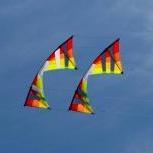Agreed. He teaches it along with his "snap spin" done exclusively with the wrists and done quickly. That motion will always cause a drop, with a greater drop the slower you do it.
I tried working through his steps, but on level four threw it away. Joe did a great thing as a designer 35 years ago and was a great pilot, still good at it, but his skill is better as a salesman than an instructor. Collectively we need more educational training, and step by step is good, but those instructions are lacking.
The bicycle is a continuous transition. You need to be comfortable holding the kite in any orientation, and then learn to transition between them. The bicycle turn can then be taken as slowly as you want, transitioning from one hovering orientation to the next.
It is more like pedaling and bike which I believe is where the name comes from. Just like pedals require large motion in knees and hips, slow bicycle turns require motion in shoulders and elbows. At the left facing and right facing direction one arm should be drawn back and the other extended. For me in most wind the upper side is drawn back near my elbow or even behind it, then pushed back out and on the other end of rotation, my opposite hand is back by the elbow. Done slowly it is a big body motion. Done quickly it might be a small distance back to the wrist or forearm, but certainly is not the twist of the wrist the video describes.
Just watched that clip again and shuddered at at. Calls it "multispins", done entirely with the wrist, stating you do an aggressive 3/4 spin and let momentum carry it through the turn. He also says the motion requires strong wind and needs a vertical pop to stay up (0:30, and 0:55) warning if you don't have both strong winds and a quick pop to stay up it will fall. I also noticed he mostly shows his hands but doesn't show the kite. In the few moments he does show the kite, 0:40-0:41, 0:48-0:50, and 1:03-1:05 there is a SIGNIFICANT drop in the air. He describes it as doing the spins QUICKLY and relying on momentum to keep the kite up, then correcting to recover and regain altitude.
Here is an old (free) article with a video near the bottom, notice the arm motion is fully to the elbow in order to maintain height at the left-facing and right-facing positions. And here is the (paid) tutorial from this site, that breaks it down in turns of hover to hover to hover, again showing large motion of the arms. In contrast, all these instructions say to go SLOWLY, as slow as you need, to maintain a solid hover at every position. Instead of using speed and momentum to rush through, they recommend first mastering a hover in any direction. Own your hover.
